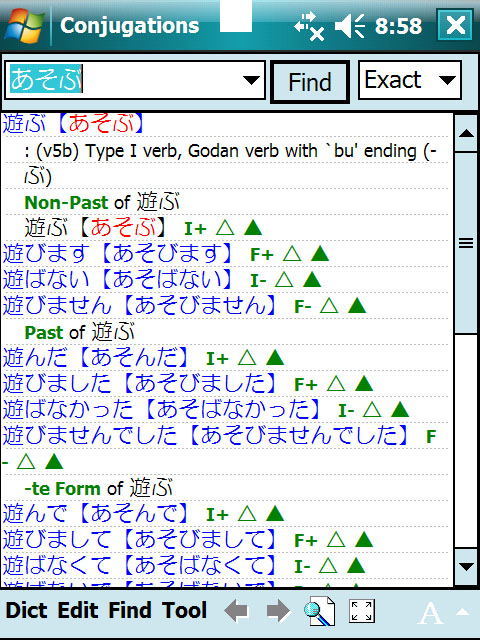
Conjugations is a pretty simple idea (the implementation, not so simple). It's a a conjugation guide for every verb in Edict (plus a few extra from other sources for good measure). Simply enter any verb to search Conjugations, or select any verb in Edict (or almost any in Waeijiro or other dictionaries) and jump to Conjugations to see how to conjugate it. Want to find the causative form of "あそぶ"? No problem.

You can see some of
the features of the
new version of Conjugations here. First, the layout makes it much
easier to read and understand than before. Second, there's more
information. Tap the name of a tense and you'll automatically jump to a
brief
explanation of that tense (then just tap the back arrow ![]() to get back to this
screen). I, F, +, and - are for Informal, Formal,
Positive, and
Negative--that's pretty easy to remember, but if you
forget, just tap
that code and you'll jump to an explanation.
to get back to this
screen). I, F, +, and - are for Informal, Formal,
Positive, and
Negative--that's pretty easy to remember, but if you
forget, just tap
that code and you'll jump to an explanation.
You can look up a verb or jump from a verb in Edict or another dictionary (here's how to jump in EB Pocket on Windows Mobile, as in the JLT Complete System). You can enter a word either in kanji and hiragana or all in hiragana (e.g., for the search shown above, you can enter 遊ぶ or あそぶ), and you can use all the normal input tools your OS and program allow (see here for the different ways to enter text in the JLT Complete System). You can also enter the conjugated form of any very you see; let's say I see the word "あそばない" and I don't know what verb it is or what tense it is. When I search for it Conjugations, I get the result below:
Notice that the result
for the term I
searched for, あそぶない, is right at the top of the results screen--the
heading showing the tense is somewhere above the screen, out of sight.
This
is due to how the dictionary program works, but it's no problem. Simply
tap or click the open triangle icon ![]() to jump up a bit and display that heading, as
you can see below.
to jump up a bit and display that heading, as
you can see below.
You can tap
the solid triangle ![]() to jump up to the first line of the entire
entry for the verb, as shown below.
to jump up to the first line of the entire
entry for the verb, as shown below.
From here, you can tap
the
back arrow ![]() to go back to where you started. A few more hints about Conjugations and EBPocket:
to go back to where you started. A few more hints about Conjugations and EBPocket:
Conjugations comes in EPWING format only. EPWING is the format used by EBWin on Windows, EB Pocket on Windows Mobile and the iPhone/iPad/iPod Touch, and various programs on Mac, Linux, Maemo (Nokia Internet Tablet), Android, and others; it's the format I recommend for anyone building a Japanese dictionary system because of the features it allows, especially the powerful different search types.
For Palm users and others who prefer the old PDIC format, there is a simpler, far tinier version available in PDIC format--it just gives a chart for each verb type (not for each individual verb). To find the conjugation for a word in Edict, you'd highlight its verb code and jump from there; it doesn't allow you to enter the conjugated form and find the root and tense. You can download the PDIC format version here.
Download the file from the link above, unzip it, and then copy the entire resulting folder to the EB Pocket Dics folder on your memory card (if you had the old version of Conjugations, you should delete the old Conjugations folder first). If you use a card reader to do the transfer, please remember to take the proper step before removing your card from the reader or the reader from your computer (Windows: right click on the removable drive letter representing the card in Computer or My Computer, wait a few seconds, then remove the card from the reader; Mac: drag the folder representing the card on your desktop into the trash, wait a few seconds, then remove the card from the reader). Then use the Edit Group function in EB Pocket to install the dictionary.
The old version of Conjugations had numerous errors in the conjugations of the kuru verbs (type vk in Edict). There are only about 20 of these, but the main one, 来る【くる】, is a pretty common and important verb. There were also a few errors in the more obscure tenses of the mostly obscure zuru and jiru type verbs. All told, the entries for fewer than 100 verbs, less than 1% of the roughly 10,000 in Conjugations, had errors. But, of course, zero is even better. If anyone should find any errors in the new version, please let me know, either by email if you have my address or through the comment box at the bottom of the inquiry form.